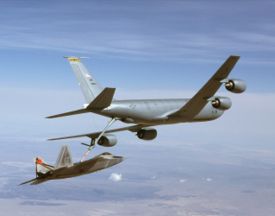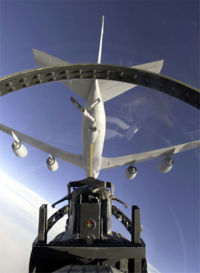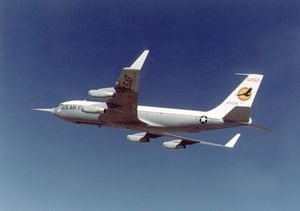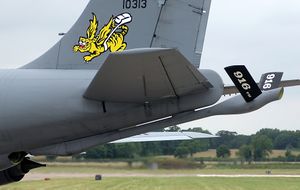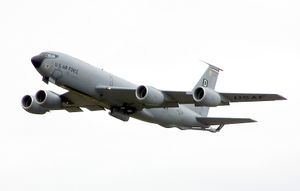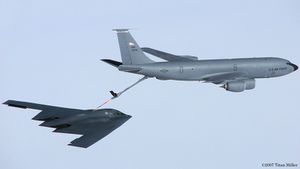PlaneSpottingWorld welcomes all new members! Please gives your ideas at the Terminal.
KC-135 Stratotanker
| KC-135 Stratotanker | |
|---|---|
| KC-135R refuels a F-22A Raptor | |
| Type | Aerial refuelling and transport |
| Manufacturer | Boeing |
| Maiden flight | August 17, 1956 |
| Introduced | June 1957 |
| Status | Active service |
| Primary users | United States Air Force Armée de l'Air Republic of Singapore Air Force Türk Hava Kuvvetleri |
| Produced | 1954-1965 |
| Unit cost | US$39.6 million (FY98 constant dollars) |
| Developed from | Boeing 367-80 |
| Variants | C-135 Stratolifter C-137 Stratoliner |
The Boeing KC-135 Stratotanker is an aerial refueling tanker aircraft, first entered service in 1957 and expected to remain in service into the 2040s.
Contents
Development
The KC-135 is derived from the original Boeing jet transport "proof of concept" demonstrator, the Boeing 367-80 (commonly called the "Dash-80"). As such, it has a narrower fuselage and is shorter than the Boeing 707 jetliner.
Developed in the late-1950s this basic airframe is characterized by swept wings and tail, four under wing mounted engine pods, a horizontal stabilizer mounted on the fuselage near the bottom of the vertical stabilizer with positive dihedral on the two horizontal planes and a hi-frequency radio antenna which protrudes forward from the top of the vertical fin or stabilizer. These basic features make it strongly resemble the commercial Boeing 707 and 720 aircraft although, under the skin, it is actually a different aircraft.
The Strategic Air Command had the KC-135 Stratotankers in service from 1957 through 1991 and with the Air National Guard and Air Force Reserve from 1975 through 1991, when they were re-assigned to the Air Mobility Command. Reconnaissance and command post variants, including Boeing EC-135 Looking Glass, Post Attack Command & Control Systems were operated by SAC from 1963 through 1991, when they were re-assigned to the Air Combat Command.
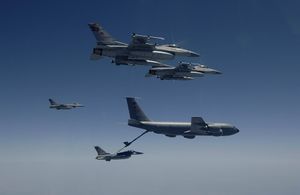
Boeing's 367-80 was the basic design for the commercial Boeing 707 passenger aircraft as well as the KC-135A Stratotanker. In 1954 the USAF's Strategic Air Command ordered the first 29 of its future fleet of 732. The first aircraft flew in August 1956 and the initial production Stratotanker was delivered to Castle Air Force Base, California, in June 1957. The last KC-135 was delivered to the Air Force in 1965.
Four turbofans, mounted under 35-degree swept wings, power the KC-135 to takeoffs at gross weights up to 322,500 pounds (146,300 kg). Nearly all internal fuel can be pumped through the tanker's flying boom, the KC-135's primary fuel transfer method. A special shuttlecock-shaped drogue, attached to and trailing behind the flying boom, may be used to refuel aircraft fitted with probes. A boom operator stationed in the rear of the aircraft controls the boom while lying on their stomach. A cargo deck above the refueling system can hold a mixed load of passengers and cargo. Depending on fuel storage configuration, the KC-135 can carry up to 83,000 pounds (37,600 kg) of cargo.
In Southeast Asia, KC-135 Stratotankers made the air war different from all previous aerial conflicts. Midair refueling brought far-flung bombing targets within reach. Combat aircraft, no longer limited by fuel supplies, were able to spend more time in target areas.
Air Mobility Command (AMC) manages more than 546 total aircraft inventory Stratotankers, of which the Air Force Reserve and Air National Guard fly 292 in support of AMC's mission.
Modifications
General upgrades
The KC-135Q was the variant modified to carry the JP-7 fuel necessary for the SR-71 Blackbird, segregating the JP-7 from the KC-135's own fuel supply (the body tanks carrying JP-7, and the wing tanks carrying JP-4). When the KC-135Q model received the CFM-56 engines, it was redesignated the KC-135T model, which was capable of separating the main body tanks from the wing tanks where the KC-135 draws its engine fuel.
The KC-135R/T was a receiver-capable tanker, used for pilot training and operational refueling missions. Currently all KC-135R/T models (Receiver capable) are with the 22nd Air Refueling Wing at McConnell AFB, KS[citation needed]. Most of these are used for force extension and Special Operations missions, and are crewed by highly qualified receiver capable crews. If not used for the receiver mission, these aircraft can be flown just like any other KC-135R.
In order to expand the KC-135's capabilities and improve its reliability, the aircraft has undergone a number of upgrades. Among these was the Pacer-CRAG program (CRAG=Compass, Radar and GPS) which ran from 1999 to 2002 and modified all the aircraft in the inventory to eliminate the Navigator position from the flight crew. The modifications were performed by BAE Systems at the Mojave Airport in California.[1]
Re-engining
Of the original KC-135As, more than 410 have been modified with new CFM56 engines produced by CFM-International. The re-engined tanker, designated either the KC-135R or KC-135T, can offload 50% more fuel, is 25% more fuel efficient, costs 25% less to operate and is 96% quieter than the KC-135A.
Under an earlier modification program, 157 Air Force Reserve (AFRES) and Air National Guard (ANG) tankers were re-engined with the Pratt & Whitney TF-33-PW-102 engines from retired 707 airliners. The re-engined tanker, designated the KC-135E, is 14% more fuel efficient than the KC-135A and can offload 20% more fuel.
Multi-Point Refueling System program
This program adds pods to the KC-135's wings. The pods allow refueling for US Navy and NATO aircraft while keeping the tail mounted refueling boom.[1]
Research and development
Besides its primary role as an inflight aircraft refueler, the KC-135, designated NKC-135, has assisted in several research projects at the NASA Dryden Flight Research Center at Edwards Air Force Base, California. One such project occurred between 1979 and 1980 when special wingtip "winglets", developed by Richard Whitcomb of the Langley Research Center, were tested at Dryden, using a NKC-135A tanker loaned to NASA by the Air Force. Winglets are small, nearly vertical fins installed on an aircraft's wing tips. The results of the research showed that drag was reduced and range could be increased by as much as 7 percent at cruise speeds.[2][3] Winglets are now being incorporated into most new commercial and military transport jets, as well as business aviation jets.
NASA also has operated several KC-135 aircraft (without the tanker equipment installed) as their infamous Vomit Comet zero-gravity simulator aircraft. The longest-serving (1973 to 1995) version was KC-135A 59-1481, named Weightless Wonder IV registered N930NA.[4]
Electronic warfare
A number of KC-135A and KC-135B aircraft have been modified to EC-135 configuration for use in several different roles.
Recent Developments
In January 2006, Secretary of Defense Donald Rumsfeld announced the cancellation of the KC-767 lease which would have replaced some of the KC-135 fleet. This followed public revelations of corruption in how the contract was awarded, as well as controversy regarding the original leasing rather than outright purchase agreement. This is also designed to be a cost-cutting measure and is part of a larger reorganization and redefinition of the Air Force's mission that includes the retirement of the E-4B fleet, the cancellation of the Boeing 767-based E-10 MC2A program, as well as the elimination of all but 58 B-52 Stratofortresses. Secretary of Defense Rumsfeld states that this move will in no way impair the Air Force's ability to deliver the mission of the KC-767, which will be accomplished by continuing upgrades to the KC-135 and KC-10 Extender fleet.
In January 2007, the Air Force formally launched the KC-X program with a request for proposals. The KC-X will replace the KC-135.[2]
Operators
- Template:FRA
- Template:SIN
- Template:TUR
- Template:USA
- Template:ITA has been reported in some sources as operating several KC-135s,[5] however these are actually Boeing 707-300s converted to tanker configuration.[6][7]
Variant summary
- KC-135A - Original production version
- NKC-135A - Test-configured KC-135A
- KC-135D - RC-135A modified to partial KC-135A configuration[8]
- KC-135E - A model modified with Pratt & Whitney TF-33-PW-102 engines from retired 707 airliners
- NKC-135E - Test-configured KC-135E
- KC-135Q - A model modified to carry the JP-7 fuel necessary for the SR-71 Blackbird
- KC-135R - A model modified with CFM-56 engines
- KC-135R/T - Receiver-capable tanker
- KC-135T - KC-135Q modified with CFM-56 engines
Specifications (KC-135R)
General characteristics
- Crew: 3: pilot, copilot, boom operator. Certain missions or aircraft(non-Pacer CRAG) require the addition of a navigator
- Length: 136 ft 3 in (41.53 m)
- Wingspan: 130 ft 10 in (39.88 m)
- Height: 41 ft 8 in (12.70 m)
- Wing area: 2,433 ft² (226 m²)
- Empty weight: 98,466 lb (44,663 kg)
- Loaded weight: 297,000 lb (135,000 kg)
- Max takeoff weight: 322,500 lb (146,000 kg)
- Powerplant: 4× (R/T) CFM International CFM-56 (F108-CF-100) turbofan engines, 21,634 lbf (96 kN) each}
- Powerplant: 4× (E) Pratt & Whitney TF-33-PW-102 turbofan engines , 18,000 lbf (80 kN) each
Performance
- Maximum speed: 580 mph (933 km/h)
- Range: 3,450 mi (5,550 km)
- Service ceiling: 50,000 ft (15,200 m)
- Rate of climb: 4,900 ft/min (1,490 m/min)
- Maximum Fuel Load: 209,543 lb (95,006 kg) (31,275 US Gallons)
References
- ↑ "BAE SYSTEMS delivers final Pacer CRAG KC-135", Aerotech News and Review, 2002-09-20
- ↑ KC-135 Aircraft Photo Gallery Contact Sheet
- ↑ C-135 Variants - Part 2, by Jennings Heilig
- ↑ C-135 Variants, Part 6 by Jennings Heilig
- ↑ Boeing wins Italian bid military 767s, SeattlePi.com; Italy operates 4 KC-135s, 2001-07-10
- ↑ Aeroflight's listing of Italian Air Force aircraft
- ↑ Airframe tracking information from Airlinerlist.com
- ↑ DoD 4120.14L, Model Designation of Military Aerospace Vehicles, May 12, 2004
External links
- KC-135 page on Boeing.com
- KC-135 image gallary on Boeing.com
- Official USAF KC-135 fact sheet
- Public domain KC-135 photo gallery at official USAF website
- Public domain photo gallery of NASA's KC-135A tanker
- KC-135 page at globalsecurity.org
- KC-135 page at fas.org - (not updated since late 1999, but still perhaps useful)
- C-135 page at aero-web.org - Includes specs for many variants
- Smart Tankers (Defence Today)
Related content
Related development
Comparable aircraft
Designation sequence
See also
Lists relating to aviation | |
|---|---|
| General | Timeline of aviation · Aircraft · Aircraft manufacturers · Aircraft engines · Aircraft engine manufacturers · Airports · Airlines |
| Military | Air forces · Aircraft weapons · Missiles · Unmanned aerial vehicles (UAVs) · Experimental aircraft |
| Notable incidents and accidents | Military aviation · Airliners · General aviation · Famous aviation-related deaths |
| Records | Flight airspeed record · Flight distance record · Flight altitude record · Flight endurance record · Most produced aircraft |
de:Boeing KC-135 es:KC-135 Stratotanker it:Boeing KC-135 Stratotanker hu:KC–135 Stratotanker nl:Boeing KC-135 Stratotanker ja:KC-135 (航空機) no:Boeing KC-135 Stratotanker ru:Боинг KC-135 fi:KC-135 Stratotanker tr:KC-135 Stratotanker
